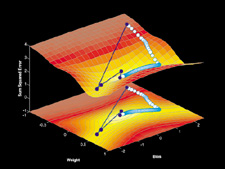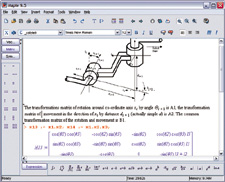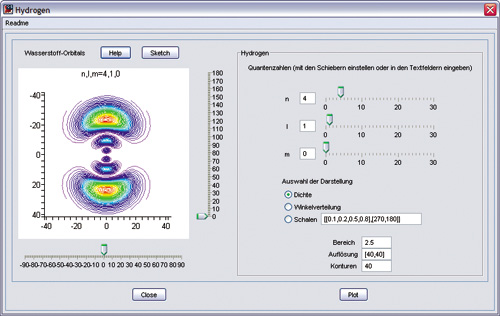Latest News
June 1, 2004
By Alan Joch

The goals of good engineering are clear: accurate and cost-effective designsthat meet time-to-market demands. To achieve these goals, engineers increasinglywork in teams as ad-hoc workgroups to pull together individuals with needed expertisefrom within a department or across the enterprise. As a result, a really hottopic these days is the collaboration that facilitates this process. But almostlost in the shuffle is an equally essential component of design success, a systemfor capturing and distributing the underlying mathematics of every design.
Above, left: Mackichan’s Scientific Workplace simplifies interaction betweenmathematicians and the rest of the world. The software has produce a Kuen’s Surface(Top). The MathWorks’s MatLab uses graphics to aid communications (Bottom).
Whether it’s the calculations that determine a product’s physical dimensionsand materials, or the algorithms used later in the design cycle for modeling andsimulations, successful engineering workgroups must literally “do the math.”
Complex Math Collaboration Requires an Interface“This interface is central to whole process,” says Bill Walster, senior researcherat Sun Microsystems Laboratories of Menlo Park, California. Sun is currently investigatingnew ways of performing arithmetic computations and developing new user interfacesfor math programming. “Computers have gotten faster, but the work engineers dohas gotten harder because designs are becoming more complex.”
Walster is not the only one observing this phenomenon. Research scientists withmathematics software companies report that over the next year, engineers willhave new and better tools for dealing with this complexity. Specifically, thesescientists point to three key trends in math programs:
- Greater collaboration capability within math applications
- Integrated environments for math calculations, modeling, and simulation
- Increasing availability of XML and its emerging subset, MathML
Razdow refers to documenting and preserving the underlying math in the designprocess as “calculation management,” a strategy that fits within the realm ofproduct lifecycle management (PLM) in furthering collaboration among engineersand enabling them to reuse intellectual capital. Because today’s design, manufacturing,and business goals cross disciplinary boundaries, the teams that create new productsmust reflect this cross-functional reality, which lies at the heart of calculationmanagement.
“Enterprises need an infrastructure for managing the information being producedby engineers,” Razdow explains. “Engineering calculations are critical to thedesign process because they take place early in the product lifecycle, so bigdecisions about what materials to use on, say, the wing of an aircraft, are usuallymade by mechanical and structural engineers doing these early calculations.” Asmathematics applications evolve, they will be differentiated not simply by theirability to perform calculations, but on how well they can capture design information,subject it to best practices, and create a corporate asset, Razdow believes.
To do this, math applications give engineers an alternative to spreadsheet programs,which some studies indicate about 40 percent of engineers currently use to dotheir math. However, spreadsheet-based calculations rarely live beyond the immediateproject because it’s hard to archive and distribute them. By sharing the actualcalculations or relevant parameters from project to project, organizations candevelop best practices that use consistent assumptions,the strength of a particulartype of steel, for example,across the organization.
Calculation consistency is especially important for organizations that employlarge groups of engineers working on a common project in many locations. “If youwant to protect against the brain drain of a person leaving and not knowing whathe did, you need to manage the process of how engineers do day-to-day calculations,“Razdow adds.
MATLAB graphics enhance insight into neural network behavior. This plot comparestraining rates for back propagation (108 steps) and the Levenberg-Marquardt method(five steps). Courtesy of The MathWorks, Inc.
Integration Platforms to the RescueA key tool in the collaboration puzzle is a framework that can integrate themath within all the various design steps. Too often, engineers carry out criticalcalculations on the fly, only to lose them forever as the design process movesforward. “How many times do engineers scribble equations and diagrams on napkins"and then try to transfer the results to electronic systems, wonders Dr. LaurentBernardin, chief scientist with Maplesoft of Waterloo, Ontario. The company’stechnical document processing platform, Maples 9.5, integrates calculation tools,modeling, simulation, and code generation in one environment. To capture calculations,the product documents each step of the design process.
“More users are realizing the limits of number crunching,” Bernardin says. “They’regetting really sick of working out the modeling of a design with pen and paperand then moving it to a numeric system.” Maples also has symbolic processing formodeling, numeric solvers for simulations, and backend code generators for deployingsystems.
Similarly, The MathWorks’s MatLab provides a technical computing environmentcomplete with a fourth-generation programming language, numerical algorithms,and tools for engineering analysis and visualization. “Customers need to accesslarger data sets, gain insights from these disparate data sources, then deal withlarger, more complex problems,” says Russ Minkwitz, product manager of math anddata analysis tools for the Natick, Massachusetts-based The MathWorks. “Engineersare being pressured to drive products to market faster.” As a result, designersfind themselves working with larger and larger file sizes.
 Top left: A rich worksheet environment in Maple 9.5 supports computation, visualization,and reporting.
Top left: A rich worksheet environment in Maple 9.5 supports computation, visualization,and reporting.
 Bottom left: Maplet apps let you customize the Maple 9.5 user interface and deployto the Web via MapleNet.
Bottom left: Maplet apps let you customize the Maple 9.5 user interface and deployto the Web via MapleNet.
A number of new features, including tools for more interactive programming techniques,will arrive in the next release of MatLab later this year. “Engineers will beable to leverage their work in MatLab with others in their organization,” Minkwitzsays.
For example, an engineer may take a MatLab signal processing algorithm and deployit as a Web services component so it can plug into another application used byother engineers in the organization. “Being able to quickly develop small scripts,algorithms and then bigger applications, and deploy them out in multiple formatswill become increasingly important,” he says.
What Boeing UsesMathematicians who support engineers also need tools that can help them considermultiple goals at the same time. “If you could figure out from finite elementanalysis how a structure is made, you could also figure out how to build it andhow much that would cost,” says Greg Shubin, manager of the mathematics groupat Boeing Corporation in Bellevue, Washington.
Boeing has a unique perspective on mathematics and engineering. It not only usescommercial mathematics software, but it has also dedicated some of its researchand development efforts to developing proprietary applications for the Boeingenvironment. The company is marketing internally developed applications, includinga product called Design Explorer, to other large manufacturing organizations suchas automotive companies.
XML for the Scientific MarketplaceAccording to math-software experts, XML will continue to grow as an importantstandard to make the easy distribution of algorithms, data, and related programspossible. Created as a way of adding structure to data through special descriptors,XML is establishing itself as a force in engineering calculations.
MacKichan produces Scientific Workplace, an integrated word processor, typesettingplatform, and storehouse of computer algorithms. “Our thrust is to provide moreinteraction with the rest of world,” says Barry MacKichan, CEO. “We’ve added HTMLoutput and output using XML and MathML,the specification for mathematics.”
MacKichan Software is working on a new release of Scientific Workplace that willmake it XML based. “XML will be the lingua franca for data sharing,” says MacKichan.“In time, virtually every program will produce XML and be able to read it.” WhenXML becomes ubiquitous, engineers will be one step closer to having everythingadd up.
Alan Joch is a business and technology writer based in New England. You can offer himfeedback about this article through Desktop Engineering Feedback.
Companies Mentioned in the ArticleBoeing
MacKichan Software
Maplesoft - Waterloo Maple
Mathsoft
Sun Microsystems
SyStat Software Inc.
The MathWorks
Subscribe to our FREE magazine, FREE email newsletters or both!
Latest News
About the Author
DE’s editors contribute news and new product announcements to Digital Engineering.
Press releases may be sent to them via [email protected].






